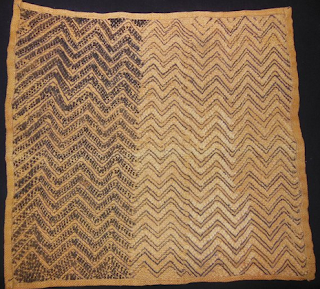Sunday, September 9, 2018
Pagne Kuba
In sub-Saharan Africa, where representative art has flourished for centuries, carvers and crafts people have typically taken for their subjects human figures, animals, plants, and elements of the natural world. Abstract art, meanwhile, has remained marginal. The textiles of the BaKuba (Kuba) people of the Democratic Republic of Congo are an exception. Although part of a tradition that stretches back 400 years, Kuba textiles have a strikingly modern look. They use improvised systems of signs, lines, colors, and textures, often in the form of complex geometric rectilinear patterns. Their appliqués are reminiscent of works by 19th- and 20th-century masters like Matisse, Picasso, Klee, Penck, and Chellida. This is no coincidence: all of those artists were inspired by Kuba design!"
"The most commonly known of the Kuba textiles are the cut-pile Shoowa or Kasai Velvets, named after the river along which the BaKuba live. Improvisation and irregularity characterize the Kasai Velvets. This is because the weaver works without a plan or preliminary sketching, though the model can occasionally be displayed on the cloth in advance using black thread. Often the design is built up from memory, repeating the most common designs and color combinations found in the region. The message conveyed is up to the artist, who is the only one who can explain what he or she intended to represent."
"Originally Kasai Velvets were used as currency, and were valuable products for trade and exchange. They could be included in the tribute villagers paid annually to the King, in the dowries of matrimonial exchanges, and in funeral gifts and offerings to the dead. They also served to embellish the royal court, cover the royal thrones, and decorate the King’s palace wall. Colonial agents and missionaries arriving in the Kuba Kingdom in the nineteenth century were fascinated by the Kasai Velvets, and encouraged women to produce more of them to adorn religious vestments for Catholic missionaries and decorate the interiors of European houses." This piece measures 18" x 20"
Subscribe to:
Post Comments (Atom)


No comments:
Post a Comment